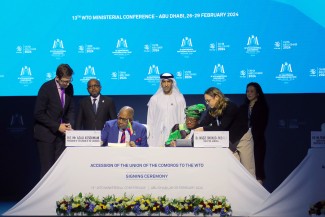|
|
|
The Trade Facilitation Agreement (TFA) of the World Trade Organisation (WTO) entered into force in 2017. Implementation of the TFA is expected to help developing and least developed countries (LDCs) reduce border inefficiencies and cut trade costs, facilitating their realisation of benefits from global commerce. The agreement sends a message that members are ready for the gradual modernisation and harmonisation of export and import processes.
Trade in wildlife – whether live plants and animals or their parts and derivatives – is no exception to this effort. The Convention on International Trade in Endangered Species of Wild Fauna and Flora (CITES) has been in force since 1975 and regulates international trade in specimens of animals and plants through a unique system of trade permits and certificates. CITES aims to ensure legal, sustainable and traceable trade. The relationship between CITES and WTO agreements has been based on mutual supportiveness.
Discussions on modernising the CITES permit issuance and management via an electronic system were initiated at the 13th meeting of the Conference of the Parties in 2004. Technological advances have since made the system and its potential benefits more available and affordable, not only for developed but also LDCs.
Balancing incentives
The road to implementation is contingent on ensuring that parties understand the benefits and purpose of an automated system. For many parties, improving trade in CITES-listed wildlife is more about ensuring the legality of trade rather than expediting the movement and clearance of goods.
A particularly important matter in the context of wildlife trade is therefore to carefully strike a balance between the incentives for efficiency and law enforcement concerns.
Early supporters of the electronic system are importing countries of high-value sectors such as luxury goods like furs and reptile leathers, and some high-volume traders such as timber and horticultural plants for which there is a business interest in reducing transaction costs for compliant traders.
Wildlife trade suffers from considerable illegal activity – both in terms of fraudulent or unregulated trade and smuggling in restricted or banned specimens. A recent World Bank report estimates the annual cost of these illegal activities at US$1-2 trillion, of which over 90% consists of lost ecosystem services that are not currently priced by the market. Direct costs of illegal trade in wildlife (excluding marine species and timber) is estimated to be up to US$20 billion per year and attracts highly organised transnational criminal groups due to the high value that certain CITES-listed species can reach.
To effectively monitor and regulate trade in wildlife assets, many authorities would benefit from automated processes and modern information management tools – not least in developing and LDCs that are often range states of multiple high-value CITES-listed species.
Implementing eCITES
While recognising the challenges regarding the costs of transitioning to an automated system, the CITES Secretariat has joined forces with various partners to develop an eCITES implementation package intended to facilitate the adoption of electronic permits worldwide.
The package contains a CITES ePermitting Toolkit with data standards and norms developed by UN/CEFACT and the World Customs Organization (WCO); an eCITES Implementation Framework with recommendations on how to plan and implement an automated/electronic CITES permitting system; an eCITES BaseSolutiondeveloped by UNCTAD which provides parties with a standards-based, low-cost software solution for the automation of CITES permit systems and electronic permit exchanges; and capacity building and advisory services provided by the CITES Secretariat to extend technical and project support associated with implementation of these tools.
Many CITES parties are currently at an early stage of implementation, and an increasing number have expressed interest in starting a project or in exploring further requirements of the package, including LDCs such as Mozambique and Vanuatu. This may be driven by moves towards the development and implementation of their national single window, as stipulated in Article 10.4 of the TFA.
Accordingly, CITES Decision 18.125 on Electronic Systems and Information Technologies, adopted at the 18th meeting of the CITES Conference of the Parties in 2019, calls on parties to consider the eCITES Implementation Framework when implementing electronic permit systems. Parties are further invited to establish ongoing collaboration between their CITES management authorities and national customs and border agencies to implement risk-based control systems for trade in CITES-listed species, which is in line with TFA Article 7.4 on risk management.
Implementation challenges
As a growing number of countries consider the automation of their CITES permitting processes, some important challenges remain.
First, CITES trade transactions are low in volume compared to many other commodity sectors. At the same time, they contain a relatively high level of specificity. Many LDCs issue somewhere between a few hundred to a few thousand permits per year for which it may be difficult to justify a high-end solution.
The UNCTAD eCITES BaseSolution was developed to address this challenge and is currently at the initial stages of rollout. Continued efforts are needed, however, to explore how best to provide access to electronic permit solutions for parties, especially poor countries, with low permit volumes but a strong need for secure and streamlined systems.
Second, parties need support in establishing risk-based electronic control systems in international trade in order to realise the full law enforcement potential of automated CITES permitting processes. Article 7.4 of the TFA stipulates that WTO members shall “adopt or maintain a risk management system for customs control” and “concentrate customs control […] on high-risk consignments and expedite the release of low-risk consignments.”
The CITES Secretariat is working with relevant partners, particularly through the International Consortium on Combating Wildlife Crime (ICCWC) to address this challenge. The WCO leads the development of various tools and training opportunities on risk management and profiling techniques for identifying high-risk consignments.
Looking ahead
Automated and simplified systems can be a powerful tool for all parties, including the poorest, to advance the CITES objective of ensuring legal, sustainable and traceable international wildlife trade.
The main challenges are threefold: strengthening the case for investing in a system where cost recovery may not be straightforward; carefully balancing trade facilitation efforts with law enforcement needs through solid risk-based control systems; and ensuring that the different solutions adopted by parties remain interoperable.
The CITES Secretariat is committed to explore how best to deliver the potential benefits while addressing these challenges. This requires creating a critical mass of countries with automated permitting and information exchange systems that weigh law enforcement cooperation with trade facilitation.
LDCs willing to explore automation are particularly important partners in this endeavour. The CITES community, with its partners, will continue to consider the most effective means to provide capacity support for these countries to realise the benefits of modernised tools and processes.
-------
Haruko Okusu is Chief, Knowledge Management and Outreach Services, at the CITES Secretariat. The author would like to thank Markus Pikart (UNECE) for his efforts during his tenure at the CITES Secretariat in 2016-2019 and for his contribution to this article.
If you would like to reuse any material published here, please let us know by sending an email to EIF Communications: eifcommunications@wto.org.




